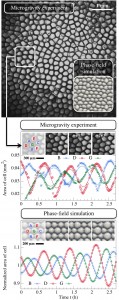May 30 2013
Researchers from Northeastern University are among the many scientists helping NASA use the weightlessness of space to design stronger materials here on Earth.
 Cellular array formed by the solid-liquid interface during a solidification experiment under microgravity conditions onboard the International Space Station (seen from the liquid). While the entire array oscillates with no global coherence at the scale of the system, locally ordered regions with hexagonal spatial ordering exhibit a sustained breathing mode oscillation of three sublattices of cells.
Cellular array formed by the solid-liquid interface during a solidification experiment under microgravity conditions onboard the International Space Station (seen from the liquid). While the entire array oscillates with no global coherence at the scale of the system, locally ordered regions with hexagonal spatial ordering exhibit a sustained breathing mode oscillation of three sublattices of cells.
Structural alloys might not sound familiar, but they are an integral part of everyday materials, such as aircraft wings, car bodies, engine blocks, or gas pipelines. These materials are produced through solidification—a process similar to the making of ice cubes. “Solidification happens all around us, either naturally, as during the crystallization of familiar snow-flakes in the atmosphere, or in technological processes used to fabricate a host of materials, from the large silicon crystals used for solar panels to the making of almost any man-made object or structure that needs to withstand large forces, like a turbine blade,” said Northeastern University Prof. Alain Karma, who was a collaborator in this study.
The transition of a structural alloy from liquid to solid is morphologically unstable, meaning that the interface between solid and liquid evolves from a planar morphology to a non-planar cellular structure during solidification—essentially, the same instability is responsible for the branched star shape of snow flakes.
But what if you could take gravity out of the mix? Researchers say by observing the solidification process in a microgravity environment—in this case, the International Space Station—they were able to study how this morphological instability develops in three dimensions to shape the structure of materials on a micron scale. “Without gravity, there is no buoyancy force to mix the atomic constituents in the melt by fluid flow,” said Prof. Karma. “As a result, solidification creates unique, more organized, structures that cannot be observed on earth. Understanding how those structures form in space gives insight for designing lighter and stronger materials that can be made on earth.”